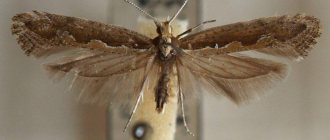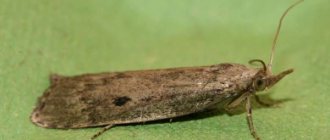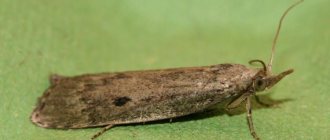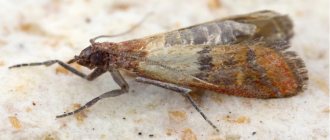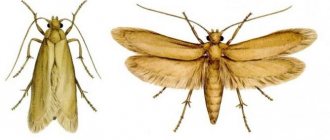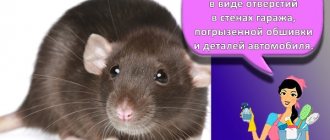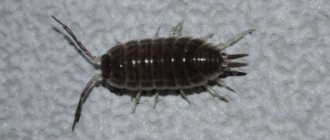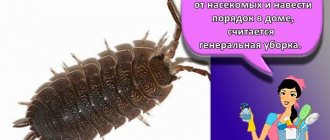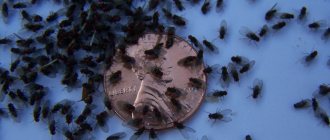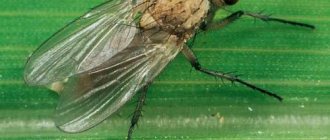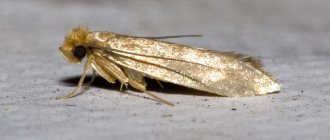House moths are widespread throughout the world and are a pest of food and things made from natural materials. These domestic parasites represent a large group, which includes several thousand species. Among themselves, they are divided into two groups according to food preference or habitat.
Butterfly moth.
What is food moth?
Externally, the kitchen moth looks like a small butterfly. Its size reaches a centimeter. The color of the wings is gray or brown. This makes it inconspicuous and allows you to hide among the products.
The insect lives for about a month and is extremely prolific. During its life cycle, it can lay many larvae in a variety of places.
The larvae of food moths look like motionless worms of white, milky or pinkish color, or light beige shades. The length can reach from 2 to 10 mm. The outer surface of the larvae is smooth and dense. Nests can be found in cereals and other groceries.
After the incubation period, small caterpillars emerge from the larvae. They begin to actively grow and develop, so they eat the food around them and spread further and further from the nest.
The caterpillar damages food by eating it and leaving excrement. Gradually, the individual’s skin hardens and a dense cocoon is formed – a pupa. By this period, the caterpillar should crawl closer to the light. She loses her skin and turns into a butterfly.
The emerging young moth immediately begins to fly from place to place, looking for places to lay larvae. The kitchen is the most attractive place for breeding. The room is always warm, there is high humidity and there is a lot of food. During the 4-6 weeks of its life cycle, the butterfly is capable of laying more than a hundred larvae.
Main species living at home
A person in his apartment most often encounters two varieties of these insects: clothes (room) moths and food moths. Representatives of these particular species are considered the most harmful and are capable of causing serious harm to humans.
Clothes moth
It is also called clothing moth. The source of nutrients for it comes from the things in our rooms: the contents of wardrobes, carpets, furniture upholstery, and even pet hairballs. Here is a small list of what a house moth larva can eat:
- woolen items;
- knitwear;
- fur coats and sheepskin coats made of natural fur;
- fur-lined shoes;
- carpet;
- cotton and cashmere clothing;
- felt boots;
- furniture upholstery;
- bedding made from natural materials.
The list can be expanded endlessly, since clothes moths can attack any item that contains natural fibers. She will not disdain “tasteless” synthetic materials if they contain at least a small percentage of cotton or wool. Even leather can be used. Particularly appetizing to her will be clothes that have been worn for a long time, with the smell of sweat and particles of shed epidermis. To get to the treasured delicacy, the moth larva is able to gnaw through even polyethylene, so packing things in a plastic bag will not save them at all.
Moth larvae eat clothes haphazardly, without giving preference to any special places. You can find holes in your favorite pullover or grooves in a fur coat in the most unpredictable places, and their size and number are proportional to the number of larvae living in the infected item.
food moth
The food moth has a richer diet, so its larvae grow much faster. The full development cycle of clothes moths sometimes takes up to six months, while for food moths it will take 3-4 months.
How is wax moth useful and what harm does it cause?
What do moths eat? The answer to this question is simple: almost any food serves as food for the larvae. Namely:
- Cereals: semolina, buckwheat, rice, corn.
- Cereals: wheat, oats, rice, barley.
- Cereals: oatmeal, corn.
- Flour
- Bakery products
- Pasta
- Sugar, nuts
- Dried fruits and seeds.
As a rule, each species prefers certain foods, but in fact it is capable of devouring absolutely everything (as most often happens).
It is noteworthy that it can settle even in the most seemingly sterile kitchen. Insufficient ventilation and high humidity in the room create comfortable conditions for its development and reproduction.
Do food moths ruin clothes?
Answer: no. If you find a pest in your food supplies, you don’t have to worry about the contents of your cupboards. The enzymatic composition of its digestive juices does not allow it to digest tissue fibers.
Danger of moths to humans
The moth does not pose a direct threat to human health. Harm can be caused by contaminated products or chemical residues after improper disinfestation.
How harmful is food moth?
Flying moths are not dangerous. The harm from it is expressed as follows:
- May get into food. Such food is not suitable for consumption.
- Larvae contaminate food.
- Threat of spreading infection. Contaminated food can cause allergies, intestinal disorders or intoxication.
- The appearance of moths raises thoughts about the presence of parasites in food. Such thoughts are fraught with psychological discomfort.
Prevention of allergic disease
Without a special laboratory examination, it is impossible to find out that moths are the carrier of the allergy. To accurately analyze the disease, a blood test is performed. It will undoubtedly determine the ratio of antibodies to pollen in the serum or other moth particles.
Using this value, you can find out not only whether there is an allergy, but also its duration and the number of contacts with an allergy carrier. In order not to doubt the occurrence of complications and further diseases, other examinations may be carried out for diagnosis. Treatment is prescribed based on the test results.
How to detect
If unpleasant flying neighbors appear in the kitchen, then you need to start auditing your food supplies. In order to get rid of insects, you need to look through the cereals and try to find the nest.
In the photo of the food moth you can see where and in what way it makes its nests. The future army of adults is concentrated in them. When visually inspecting small cereals or flour, you should pay attention to lumps and pellets.
In cereals and other groceries, fragments intertwined with thin cobwebs may be found. The larvae are located in such lumps.
Small caterpillars can be found on the walls of containers where food is stored.
Food moths prefer to nest in the kitchen:
- In containers and bags with cereals and pasta;
- In bread bins;
- In jars for storing mild spices;
- Packaged with sugar or flour.
Local types of allergies
These signs of moth allergy are most often found on the skin, in the gastrointestinal tract, on the mucous membranes of the nasopharynx and bronchial tree.
1) Common signs of skin allergies:
- red and dry skin,
- burning,
- not being able to stay in the cold or the sun for a long time,
- the appearance of blisters and papules on the skin.
These rashes can move away from the natural skin, they can change the area of existence on the skin, that is, today they are in one place, tomorrow in another.
2) Gastrointestinal symptoms of allergies:
- increased gas formation,
- pain in the stomach,
- diarrhea,
- vomit.
3) Eye signs of allergies:
- the patient may feel a foreign body in the eye,
- burning,
- tears may appear
- swelling of the eyelids,
- skin and eyelids become red.
4) Claims for allergies to the bronchial tree and nasopharynx:
- dry cough,
- nasal congestion,
- difficult breathing through the nose,
- dyspnea,
- gasping,
- lack of air,
- constant nasal discharge,
- sore throat,
- feeling of wheezing in the chest,
- sneezing.
Photo: Identifying the cause of allergies in the laboratory
One patient may have both general and local signs of moth allergy.
Methods of disposal
Destruction of a butterfly, larvae or caterpillars individually is a short-term measure. Only comprehensive measures will help get rid of the pest. It is necessary to destroy flying butterflies and nesting sites at the same time. This is the only way to stop the pest invasion.
There are effective ways to quickly get rid of food moths in the kitchen.
- If nests are found in grocery storage areas, you should immediately throw away the supplies as quickly as possible. They are no longer suitable for human consumption. There is no need to skimp on products. A larva may remain in any of them, which will become a source of new individuals.
- If, after a visual inspection, no signs of moth infestation are found in food packages, then preventive measures must be taken. Cereals are calcined in the oven at a temperature of about 60 degrees. Flour, sugar, pasta are taken out into the cold for a day.
- Absolutely all food must be removed from the cabinets. Internal surfaces should be treated with any food moth repellent. The cabinets are left open for several days, then washed with soapy water and ventilated again. Only after this procedure can you fill the shelves with supplies.
- In order to get rid of flying moths, you can use fly sticks. Butterflies stick to it and lose the ability to move.
- Special preparations are available for sale. These are sections filled with chemical compounds containing insect poison. Anti-moth tablets that are placed on shelves are effective. Larvae and caterpillars die from the smell.
- During long-term storage, products should be periodically taken out into the cold. It is necessary to ventilate cabinets more often.
Aerosols are not recommended as they will spoil the food.
Varieties of moths
There are several types of home moth; each group gives preference to its favorite product, but does not neglect others. There are eight main types of household pests.
- Flour moth. The firefly is small in size with beige colored wings. This type of insect reproduces faster than its counterparts. If you notice small cocoons in the flour, it means that the parasite has entered the house. Sift the flour through a sieve, then cook in the oven for at least half an hour. Store flour in an airtight container.
- Grain moth. A firefly with narrow wings of a yellowish tint, the color is similar to the color of grain so that it can blend in with it. She focuses on buckwheat, rice, rye and wheat. The safest way to get rid of the parasite is to use special traps.
- Mill moth. A butterfly up to 1.5 cm in size, with dark gray dotted wings. This type of moth is rarely found in apartments; they are usually found in mills.
- Potato moth. A small, inconspicuous moth with gray wings and long antennae. The larvae like to attack old potatoes, as their tubers are softer. They bite into fruits, causing rotting. You can fight potato moth by adjusting the storage temperature of root crops below 0°C. For a better effect, tubers can be treated with biological preparations.
- Onion moth. Wingspan up to 17 mm. The body and fore wings are brown, the hind wings are gray with fringe. The larvae eat the onion, causing the vegetable to rot.
- Cereal moth. A butterfly with silver-gray wings, the span of which reaches 14 mm. The larva destroys cereals and seeds, gluing the grains into pellets using a web. Its appearance indicates that the grain has already been stored in the warehouse.
- Chocolate moth. Eats coffee, cocoa beans, chocolate and other “confectionery”. She makes passages in chocolate products, leaving behind grains of feces. The size of the worms does not exceed 0.5 cm, so they fit into the smallest holes in the wrapper.
- Fruit moth. The gray butterfly, approximately 10 mm in size, is nocturnal. Moths grow in dried fruits, fruits and mushrooms. Its larvae break through canals, turning the fruits into dust. The insect does not disdain other products, so you can see moths in walnuts, almonds or hazelnuts.
In the apartment, food moths eat all grocery products. Therefore, first check for caterpillars:
- cereals;
- pasta;
- beans;
- peas;
- flour;
- sugar;
- candies;
- nuts and dried fruits;
- bread;
- cookie;
- spices;
- tea;
- coffee;
- cocoa;
- animal feed.
Different types of parasites can easily live next to each other. Therefore, when you find a moth, carefully check not only your food, but also your wardrobe.
Folk remedies against moths
People's advice offers options on how to get rid of food moths. It does not tolerate strong spicy odors, so it is recommended to use:
- Dry lavender. Bunches of dried flowers are laid out in cabinets. The butterfly flies away from the places where the dry bouquet will be placed;
- The aroma of tansy and wormwood repels moths. This smell is not tolerated not only by moths, but also by small house ants;
- Fresh dill is effective in the fight against moths. Bunches of greenery hung in the closet drive away moths. They need to be changed every three to four days;
- Blooming geraniums on the kitchen windowsill will protect the room from pest invasion.
Who bites
Man is inextricably linked with nature, and insects are part of it. Some of them have perfectly adapted to living quarters and choose our homes as their habitat. At home, up to 15 species of harmful insects can coexist with humans. Some of them pose a danger to humans, such as blood-sucking parasites.
Female mosquito
Blood-sucking mosquito.
Mosquitoes are a common type of insect that feeds on human blood. Female mosquitoes fly indoors and attack at night. Their presence can be determined by a characteristic squeak, as well as marks on the body that remain after a bite.
Mosquitoes choose places where the capillaries are closest to the skin and can provoke allergic reactions to their saliva. In some cases, mosquitoes are carriers of dangerous diseases.
Linen bugs
Linen bug.
Linen or bed bugs are parasites that lead a secretive lifestyle and attack a person most often when he is sleeping. This is where the name of these insects comes from.
They often settle on the back side of the mattress, where they hide during the day, but almost any secluded place is suitable for a permanent habitat - ventilation shafts, old boxes, cracks in the walls. Unlike a mosquito, one bug can bite repeatedly, leaving a line of punctures in the skin.
This type of parasite can also carry pathogens, but cases of infection from bedbugs are rare. However, being around bedbugs brings a lot of discomfort to people, and a room infested with them acquires a specific smell.
Common fleas
Common flea.
Most often, fleas are transmitted to humans through contact with an infected animal. They continue to parasitize humans, biting them regardless of the time of day. They are dangerous because they are carriers of a spectrum of pathologies:
- viral;
- infectious;
- parasitic.
Prevention
- Moths enter the apartment from outside. Therefore, you need to carefully consider product packaging when purchasing. The presence of lumps and unknown inclusions in a grocery product is a reason to refuse the product.
- Food supplies must be checked periodically and cupboards must be ventilated.
- The interior surfaces of shelves and cabinets should be wiped with water and vinegar.
- There is no need to make large reserves. They should be replenished as needed.
- For storage, you must use a special sealed container.
All of the above methods tell you how to get rid of food moths. But still, the best option is to carry out timely prevention.
And at the first sign of the appearance of a pest, immediately launch a comprehensive counterattack.
Proboscis - an organ that is absent as unnecessary
Butterflies need the proboscis in order to normally feed on the nectar of flowers - it is with the help of this organ that the insect can reach deeply hidden aromatic nectaries in plants. The vast majority of butterflies feed on this kind of food.
This is interesting
Despite the adaptability of butterflies to feeding on flower nectar, there are also species among them whose food preferences do not at all correspond to the “image” of these insects. For example, butterflies are known to feed on animal excrement and corpses (by the way, the largest and most beautiful butterflies in the world are among them), and there are even vampire butterflies. They can also attack humans, piercing the skin with their proboscis and sucking out a few drops of blood.
But among all the diversity of butterflies, 2000 species of moths stand apart: as adults, they do not feed at all. They simply do not need a proboscis or any other organs for eating food. This is the answer to the question why moths do not have a proboscis.
In addition to the oral apparatus, many moths as adults lack digestive organs (more precisely, they are underdeveloped). The task of adult moths is to mate and lay eggs, and therefore they live only off the nutrients that they accumulate in the larval stage.
It is the moth caterpillar that is the same pest that carefully trims the fur on fur coats in the closet, gnaws holes on sweaters and upholstery, and spoils dry cereals and other food products in kitchens and closets. The caterpillar has a powerful gnawing apparatus, which even corn groats and semi-synthetic fabrics cannot resist.
On a note
Contrary to popular belief, moths do not destroy items made from synthetic fabric. The larva can eat fabrics containing part synthetic and part natural materials, but they grow on such a diet more slowly than those that feed on natural wool or fur.
In some moth species, the gnawing apparatus is retained in the adult stage. However, this does not mean that butterflies of these species can damage clothing - they are simply less evolutionarily mature and have not yet completely lost their nutritional organs.
Butterfly moths, as a rule, do not live very long - from several days to several weeks. At the same time, females try to move as little as possible, and males fly only at night. This provides a certain safety for these insects, which fly relatively poorly and are unable to scare off predators. But there are no insects dangerous to humans among moths.
Preventive measures
The best way to prevent the recurrence of food moths in the home is to be careful when purchasing groceries. It is better to purchase cereals in transparent packages so that you can visually assess their quality. Extraneous inclusions, small lumps, thin cobwebs are signs of food moth infestation.
You should not buy products at sales - this is often the seller’s way of getting rid of insect-infested goods.
It is better to heat flour or cereal purchased at a big discount in the oven at a temperature of +80...120°C for 30 minutes or place it in the freezer overnight.
It is advisable to pack all bulk products in hermetically sealed containers so that food moths cannot reach them. Cabinets need to be cleaned regularly in order to promptly get rid of stitched or insect-infested cereals. Kitchen furniture shelves should be wiped from time to time with a strong solution of vinegar, which repels food moths.
Treatment and pain relief for bites
Treatment of bite sites is carried out in various ways, using medications, as well as folk recipes. Therefore, to reduce discomfort, use:
- Antiseptics, in the form of iodine, alcohol, hydrogen peroxide, “Miromistin”.
- Gels, in the form of “Fenistil”, “Advantan”, etc.
- Homeopathic medicines, in the form of “Apis Mellifica”, “Urtica Urensa”, etc.
Bites to the face area, including the eye area, are possible. In such cases, wash the eye mucosa with cooled strong tea. Alternatively, you can add a freshly used tea bag.
Folk remedies based on natural ingredients will help reduce negative sensations and discomfort. For example:
- A compress made from freshly picked plantain, parsley, dandelion leaves, etc. will help.
- A solution of baking soda, in the form of a porridge mixture, applied to the bite site will help relieve pain and itching.
- Alternatively, you can use a piece of raw potato, a piece of fresh cucumber, apple or tomato.
- A mixture of vodka and freshly squeezed lemon juice will also help cope with pain and severe itching.
- Onions will help solve this problem if you cut it and apply it to the problem area.
- Milk frozen in cubes and applied to the bite site will significantly reduce the feeling of discomfort.
- It is permissible to coat the bite site with chilled olive oil.
- A prepared mixture of 1 teaspoon of honey and 1 head of garlic has an antibacterial effect.
- Take an aloe leaf, remove the skin from one side and apply it to the bite site.
- A mixture of crushed activated carbon tablets and validol dissolved in water will help relieve the level of redness and burning that is characteristic of the bite site.
Decoctions and infusions prepared using natural ingredients will help reduce the level of discomfort. For example:
- A decoction based on chamomile and calendula, which is used to wipe the bite site or use as a soothing drink, can relieve pain and reduce tissue swelling.
- Basil infusion. To do this, take 3 teaspoons of this plant and pour 1 glass of boiling water. After cooling, the infusion is taken 1 tbsp. spoon 3 times a day as a sedative, and is also used for lotions.
- One tablespoon of calendula is infused in 200 grams of alcohol (70 percent) or moonshine for 3 days. After this, the infusion is diluted at the rate of 1 teaspoon per 50 ml of water. This solution is used to make lotions.
